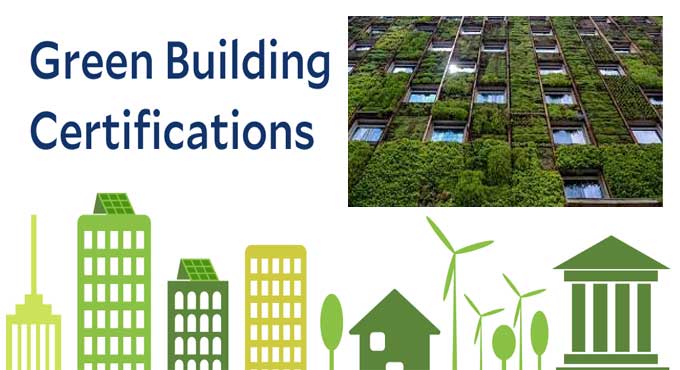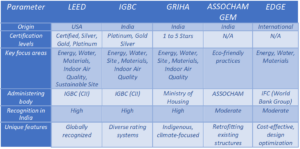
Comparing Green Building Certification Systems
As the world grapples with the critical need for sustainable construction standards, India has not lagged behind. The Indian construction sector has seen a paradigm change toward eco-friendly building design and construction. The Green Building Rating System is critical in encouraging sustainability in the built environment. To address this serious challenge, numerous Green Building Rating Systems have evolved in India.
LEED, IGBC, GRIHA, ASSOCHAM GEM, and EDGE each provide various benefits and certifications, making it critical for builders and developers to properly examine their specific needs. Selecting the best Green Building Rating Systems in India is dependent on a number of criteria, including the type of project, sustainability goals, and local regulations.
Green building grading systems have gained substantial significance in India’s construction industry as a result of increased awareness of environmental sustainability and the necessity for eco-friendly construction practices. These technologies aid in the assessment and certification of building environmental performance, ensuring that they meet high sustainability criteria.
1. Leadership in Energy and Environmental Design (LEED): The US Green Building Council (USGBC) developed LEED, which has a considerable presence in India. It assesses numerous aspects of building design and operation, such as energy efficiency, water conservation, interior environmental quality, and environmentally friendly materials. LEED certification levels are based on a point system and include Certified, Silver, Gold, and Platinum.
Key Features:
● Focuses on sustainable site development, water savings, energy efficiency, materials selection, and indoor environmental quality.
● Offers different rating levels, including Certified, Silver, Gold, and Platinum.
● Recognized for its flexibility and adaptability to various building types.
2. Indian Green Building Council (IGBC): The IGBC provides a variety of rating systems customized to various building types, including as houses, commercial spaces, and factories. It evaluates aspects like energy and water efficiency, site sustainability, materials, and indoor air quality. Platinum, Gold, and Silver IGBC certifications are available.
Key Features:
● Provides a wide range of rating systems, such as IGBC Green Homes, IGBC Green Factory, and IGBC Green Township.
● Emphasizes energy efficiency, water conservation, and sustainable materials.
● Collaborates with various stakeholders to create a sustainable built environment.
3. Green Rating for Integrated Habitat Assessment (GRIHA): The TERI (The Energy and Resources Institute) established GRIHA, India’s own green building grading system. It focuses on lowering a building’s environmental footprint while increasing tenant comfort. GRIHA assesses factors such as energy efficiency, water management, site selection, and waste management. It is rated from one to five stars.
Key Features:
● Designed specifically for Indian climatic conditions and building practices.
● Focuses on energy efficiency, water management, waste reduction, and indoor air quality.
● Offers a comprehensive framework for evaluating the environmental performance of buildings.
4. ASSOCHAM Green and Eco-Friendly Movement (ASSOCHAM GEM): The Associated Chambers of Commerce and Industry of India launched ASSOCHAM GEM (ASSOCHAM). Its primary goal is to promote environmentally friendly practices in the sector. While it is not as well-known as other systems, it strives to promote sustainability and green efforts.
Key Features:
● Focuses on retrofitting existing buildings to enhance their sustainability.
● Emphasizes energy efficiency, water conservation, waste management, and indoor environmental quality.
● Provides a pathway for older structures to become more environmentally friendly.
5. Excellence in Design for Greater Efficiencies (EDGE): The International Financial Corporation (IFC), a member of the World Bank Group, created the EDGE system. It focuses on resource-efficient design and provides certification for buildings that satisfy specific energy, water, and material savings criteria.
Key Features:
● Concentrates on resource-efficient design strategies that reduce energy, water, and materials consumption.
● Offers a cost-effective approach to green building certification.
● Allows projects to optimize their sustainability performance while maintaining affordability.
 Therefore, the implementation of any Green Building Rating System in India is a step toward a more environmentally conscious and sustainable construction industry. As environmental concerns develop, these systems will become increasingly important in influencing the future of the Indian built environment.
Therefore, the implementation of any Green Building Rating System in India is a step toward a more environmentally conscious and sustainable construction industry. As environmental concerns develop, these systems will become increasingly important in influencing the future of the Indian built environment.




